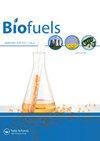Bacterial community issued from a Chlorophytum plant-microbial fuel cell for electricity generation
IF 2.6
4区 工程技术
Q3 ENERGY & FUELS
引用次数: 0
Abstract
AbstractSome microorganisms, particularly bacteria, can adhere to conductive surfaces and grow as an electroactive biofilm, on which they communicate electrochemically and generate electricity. Here, a bacterial community isolated from anodic electroactive biofilms of a Microbial Fuel Cell planted with Chlorophytum comosom is studied. Seventeen different bacterial strains were isolated from electroactive biofilms and were identified using the 16S rRNA marker gene. The strains were affiliated to 8 bacteria families and 8 genera (Aeromonas, Enterobacter, Alcaligenes, Pseudomonas, Clostridium, Paraclostridium, Enterococcus and Kurthia spp.). After that, it was demonstrated using electrochemical methods, principally imposed potential chronoamperometry under +0.155 mV/SCE, that the consortium constituted of 17 strains was able to exchange electrons with conductive materials. A maximum current density of 345 µA/cm2 was revealed at 48h of the study, using acetate as the sole carbon source and without any additional external mediator.Keywords: ChronoamperometryMFCbioelectricityelectroactive bacteriaelectroactive biofilmextracellular electron transfer Disclosure statementNo potential conflict of interest was reported by the authors.从吊兰植物中产生的细菌群落-微生物燃料电池发电
【摘要】一些微生物,尤其是细菌,可以附着在导电表面并生长为电活性生物膜,它们在其上进行电化学交流并发电。本文研究了从种植吊兰的微生物燃料电池阳极电活性生物膜中分离出的细菌群落。从电活性生物膜中分离到17株不同的细菌菌株,并利用16S rRNA标记基因进行了鉴定。菌株隶属于8个菌科8属(气单胞菌、肠杆菌、Alcaligenes、假单胞菌、Clostridium、Paraclostridium、Enterococcus和Kurthia spp)。之后,使用电化学方法(主要是施加电位计时安培法)在+0.155 mV/SCE下证明,由17株菌株组成的联盟能够与导电材料交换电子。在研究的第48小时,以醋酸盐作为唯一的碳源,没有任何额外的外部介质,最大电流密度为345µA/cm2。关键词:时序电流计ymfc生物电活性细菌电活性生物膜胞外电子转移披露声明作者未报告潜在利益冲突。
本文章由计算机程序翻译,如有差异,请以英文原文为准。
求助全文
约1分钟内获得全文
求助全文
来源期刊

Biofuels-Uk
Energy-Renewable Energy, Sustainability and the Environment
CiteScore
5.40
自引率
9.50%
发文量
56
期刊介绍:
Current energy systems need a vast transformation to meet the key demands of the 21st century: reduced environmental impact, economic viability and efficiency. An essential part of this energy revolution is bioenergy.
The movement towards widespread implementation of first generation biofuels is still in its infancy, requiring continued evaluation and improvement to be fully realised. Problems with current bioenergy strategies, for example competition over land use for food crops, do not yet have satisfactory solutions. The second generation of biofuels, based around cellulosic ethanol, are now in development and are opening up new possibilities for future energy generation. Recent advances in genetics have pioneered research into designer fuels and sources such as algae have been revealed as untapped bioenergy resources.
As global energy requirements change and grow, it is crucial that all aspects of the bioenergy production process are streamlined and improved, from the design of more efficient biorefineries to research into biohydrogen as an energy carrier. Current energy infrastructures need to be adapted and changed to fulfil the promises of biomass for power generation.
Biofuels provides a forum for all stakeholders in the bioenergy sector, featuring review articles, original research, commentaries, news, research and development spotlights, interviews with key opinion leaders and much more, with a view to establishing an international community of bioenergy communication.
As biofuel research continues at an unprecedented rate, the development of new feedstocks and improvements in bioenergy production processes provide the key to the transformation of biomass into a global energy resource. With the twin threats of climate change and depleted fossil fuel reserves looming, it is vitally important that research communities are mobilized to fully realize the potential of bioenergy.
 求助内容:
求助内容: 应助结果提醒方式:
应助结果提醒方式:


